Sliding screen for the bath: step-by-step instructions for assembling the factory design + tips for craftsmen
The space under the bathroom is not very attractive from an aesthetic point of view: pipes are located there, and sometimes a mini-closet for household chemicals and detergents is located. To improve the interior, a sliding screen is installed under the bathtub - a simple design of the frame and movable wings.
Do you want to assemble such a screen with your own hands, but have never done it? We will help you deal with the main points - this material describes in detail the stages of assembly and installation of the screen. We also presented the advantages of such a design and useful information about which models are the most acceptable in terms of cost and reliability.
The content of the article:
Benefits of Sliding Screens
There are several types of screens that are mounted under the bathroom. Simple installation is characterized by solid products without doors. Their main plus is the ability to use any building and finishing material, from bricks and drywall to tiles and plastic.
Screens with drawers, sliding or hinged doors allow you to use the hidden area as a storage system. Thanks to this, space in cabinets is greatly saved, and all tubes, bottles, packs of detergents can be assembled and arranged in one place. More about the device of sliding and integral types of screens we wrote here.
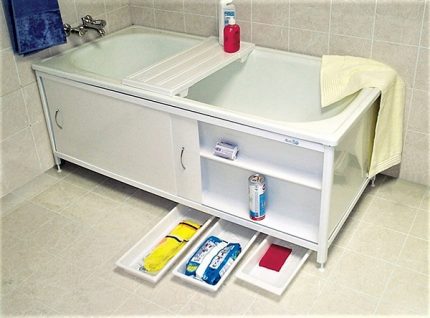
Thus, several issues are resolved at once:
- Useful space of a bathroom or bath increases;
- there is a convenient and affordable place to store household chemicals;
- the appearance of the room becomes more attractive.
Less sliding structures in a limited selection of material. Sashes should be light and thin, so that they can easily move along the guides, therefore, we exclude the tile or GKL.Plywood is not suitable, as it quickly deforms in a humid microclimate.
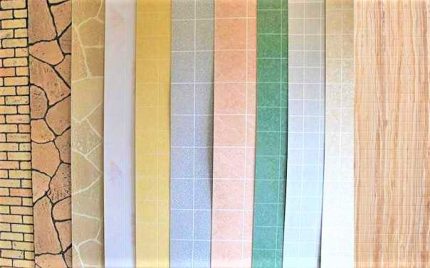
Laminated boards of chipboard, MDF are slightly heavier, but they are also used for the manufacture of sliding structures.
Owners have a choice: buy a finished model or assemble a screen from scratch with their own hands. Given the low cost of factory products, we recommend that you purchase a screen that is fully prepared for installation. It is equipped with mounts and instructions, so you can fix it under the bathtub easily and quickly.
For self-assembly, it will require calculations, the selection of a suitable material, and additional processing of parts. This will take a lot of time, and the result may not be the most impressive.
Factory Model Assembly Instruction
Before installation, you need to buy / order a screen or a set of individual parts from which the frame and sashes will be formed. Before buying, you should consider the design of the product - it should be in harmony with the wall and floor linings, consistent in color and texture.
A few successful examples of installing a "scaffold":
If you decide to make a screen yourself, we recommend that you first study the finished models sold in the store. So you will understand exactly what details will be required for making a functional screen and whether they can be purchased separately.
Stage # 1 - selection of necessary tools
It all depends on whether you buy a factory model or are going to prepare parts yourself. In the first case, a Phillips screwdriver and a wrench, which is often attached to the kit, are enough.
The second will require tools for cutting and grinding: a jigsaw, a file, a construction knife, sandpaper for processing the ends.
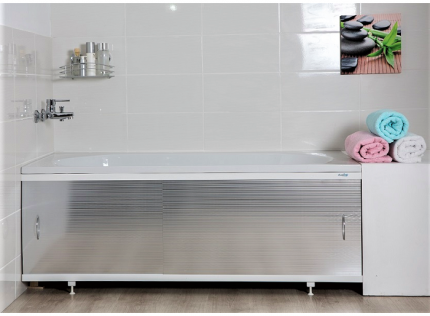
If the guides will be attached to the floor, and the vertical racks to the walls, then a puncher or drill, as well as a set of dowels and nails, are useful.
Necessarily marking tools - tape measure, square, level, pencil. They will come in handy even before buying a screen to clarify the sizes.
Stage # 2 - checking the configuration and inspection of parts
When buying models from plastic or MDF, all details can be checked according to the list specified in the instructions.
Typically, the package includes:
- 2-3 panels;
- 2 guides - upper and lower;
- 2 side racks;
- threaded legs (from 2 to 4);
- 2 handles with screws;
- hex key;
- step-by-step schematic instructions.
It is necessary to carefully inspect every detail: check the legs for strength, make sure that the panels are not scratched and have smooth edges without nicks.
For self-assembly, you will have to find suitable panels made of plastic or MDF. If they are larger in size, this is not scary - extra centimeters can be cut off.You will also need a plastic or metal profile for the manufacture of guides. The main thing is that he has two “tracks”.

The frame can also be made of wood, if you have at hand a tool for processing wooden blocks. But do not forget to polish every detail, treat it with protective impregnation and cover it with paint or varnish. So the wood will last much longer.
Stage # 3 - preparing the installation space
Before installation work, it is better to prepare the floor and walls in advance - finish the repair, remove excess garbage. We recommend tidying up the space under the bathroom: treat the concrete surfaces with a sealant anti-mold compound, wipe the tile seams, wash everything thoroughly.
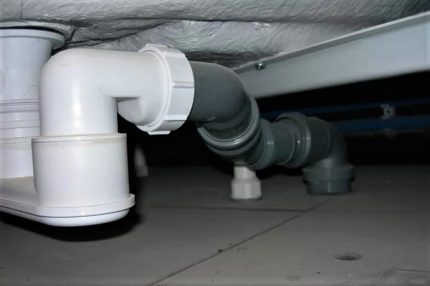
Some pipes run along the walls - this should be considered when processing panels. Sometimes you have to cut a corner, otherwise the screen will not "fall" into place. We do not recommend installing a “deaf" element in the pipe passage, otherwise, if a leak occurs, you will have to dismantle the entire screen.
Now let's look at how to quickly assemble and install a sliding screen under the bathtub.
Stage # 4 - installation of the frame under the bathroom
Some models are sold almost assembled. The frame together with the doors fixed in it is packed in a plastic film, in a separate package - legs and fasteners.
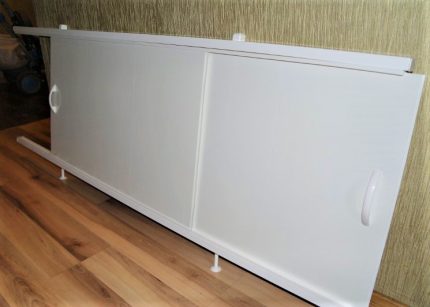
For purchased models, representing a set of individual parts, the screen is installed in the following order:
1 step - frame assembly
We put horizontal guides parallel to each other, with grooves towards. We place racks from the sides, also with grooves to the center.
We get the plugs from the uprights, insert the locks into the grooves of the guides, align the resulting frame and tighten the fasteners. The result was a rectangular frame.

2 step - fixing the panels
We insert the panels into the lower profile so that they fall into different “tracks” (as a rule, there are two of them, like the panels). Adjust the upper guide in height, tighten. We make sure that the profile and the wings do not touch closely - a small gap provides an easy move.
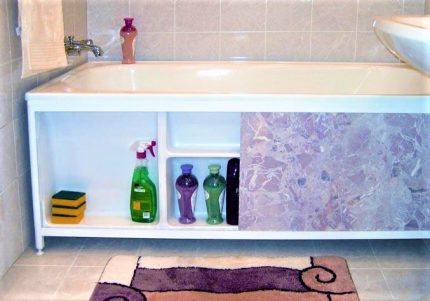
3 step - installation of legs and installation of handles
We insert bushings with legs into the uprights - from the bottom end, where the plugs were originally located.
We also fasten the handles that come with the screws.
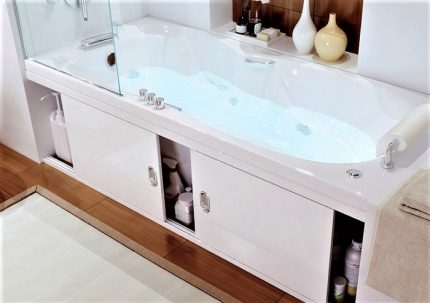
4 step - installing the screen under the bath
We start the screen under the external side of the bathtub, align it with the floor, unscrew the adjusting legs until they stop, so that the frame "stands up" tightly and does not fluctuate when opening / closing the panels.

Pay attention to the manufacturer's recommendations.For example, to install a screen under a steel or cast-iron bath, it is usually advised to remove the upper bushings.
And for installation under an acrylic bathtub with a deep shimmer, they also suggest using the upper legs.
Features of making a screen on your own
With self-assembly, the installation procedure can be changed. For example, sometimes the lower guide - “rails” is fixed, and then the panels are inserted into it together with the upper profile. But in this case, the parts must be very precisely sized or adjusted using the upper legs.
Our site has step-by-step instruction on self-production of the screen and installation of homemade products.
Some more general helpful tips:
Often, amateurs who make their own bath screen for the first time forget about the legs and mount the lower guide directly to the floor.
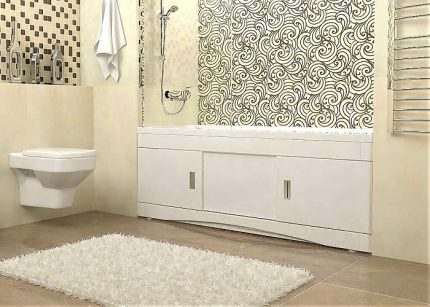
In the future, this decision will make the use of the bath uncomfortable. It will be difficult to care for the bathroom, as standing near a continuous screen is inconvenient.
If installing a sliding model for some reason is not possible, do not forget about alternative solutions - screens with a hatch or a hinged door.
Conclusions and useful video on the topic
Detailed video instruction from the manufacturer:
How is the screen assembly assembled:
Homemade budget review:
A variety of screens allows not only to equip a convenient storage place under the bathroom, but also to style the screen from the outside using mosaics, 3D panels, mirrors, tiles and other materials. Installation of the factory model is not difficult and takes a minimum of time, you will have to tinker with a self-made screen a little longer.
Are you assembling a purchase screen and have any questions during the execution of the work? Ask them to our experts in the comments section, add a photo with instructions from the manufacturer - we will try to help you.
Or maybe you have successfully coped with the self-assembly of the screen and modified it a bit by putting convenient stands or a cabinet with shelves in it to comfortably place detergents inside the package? Share the results of your work with other users - add photos of an improved screen design.

 How to install a bath on bricks: step-by-step instruction on how to install
How to install a bath on bricks: step-by-step instruction on how to install 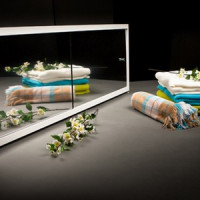 How to make a mirror screen for a bath: step by step instructions
How to make a mirror screen for a bath: step by step instructions 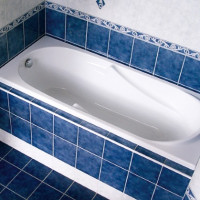 How to make a screen for a bathtub from a tile: methods of self-arrangement
How to make a screen for a bathtub from a tile: methods of self-arrangement 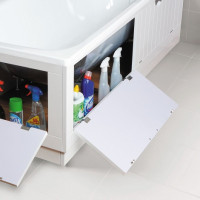 How to make a screen under the bath yourself: analysis of the nuances of installation
How to make a screen under the bath yourself: analysis of the nuances of installation 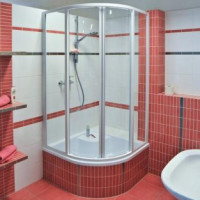 Connection of a shower cabin to the sewerage and water supply: step-by-step instruction
Connection of a shower cabin to the sewerage and water supply: step-by-step instruction 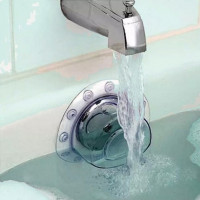 Bath harness: overview of the types of drain-overflow systems + step-by-step installation instructions
Bath harness: overview of the types of drain-overflow systems + step-by-step installation instructions  How much does it cost to connect gas to a private house: the price of organizing gas supply
How much does it cost to connect gas to a private house: the price of organizing gas supply  The best washing machines with dryer: model rating and customer tips
The best washing machines with dryer: model rating and customer tips  What is the color temperature of light and the nuances of choosing the temperature of the lamps to suit your needs
What is the color temperature of light and the nuances of choosing the temperature of the lamps to suit your needs  Replacement of a geyser in an apartment: replacement paperwork + basic norms and requirements
Replacement of a geyser in an apartment: replacement paperwork + basic norms and requirements
I really liked the option in one of the photos above, where the design of the “vanilla” implies a small area of the bathtub itself, open to the eyes. It is clear that the bathtub for such a design should be perfectly clean, even, and even new in general, but this is the best of everything that I have seen.
There is a good version of the “vanity” - a small metal grill. In most bathrooms, where the owners made a solid screen, when opening the doors, the nose does not have the best aroma. Or dampness, or musty, or household chemicals that are stored there. And only the grill guarantees 100% ventilation of the space inside, and at the same time, the aesthetic function is not lost. The lattice is beautifully painted in any color, it can be larger or smaller. It’s a pity, there is no photo insert button here - I would show how the bath screen from the grill looks like.
We made a sliding screen ourselves. This is not difficult, the main thing: to be able to make a crate of wooden battens and fix it around the bathtub with a mounting foam. A plastic profile was nailed to it, into which plastic panels were inserted. My husband all the work took several hours. But we did not think of internal shelves. What's the beautiful! As we will do the repair, I will order a finished screen with shelves and doors in the manner of a cabinet.
We have a standard plastic screen under the bathtub and there was a problem with it - a piece broke off on the lower guide and now the screen seems to fall out of it. Walked through household stores - nowhere separately is the guide sold. Are they even available for sale or will you have to buy and change a completely new screen? Or maybe something can be repaired?
Personally, I did not come across plastic guides for the screen for the bathtub on sale.
If the broken off piece is preserved, then you can try to glue it to the same place. Good plastic adhesion “Super Moment”, “Moment plastic”, “Cosmofen”, “Second”. Before gluing, you can walk a little sandpaper on glued plastic. The resulting roughness will give a better adhesion of parts. You need to apply so much glue so that during its connection and compression its excess does not protrude.
On the other hand, if this is such a standard screen that I think about, is it worth it to mess with? Isn’t it easier to buy a new one, since it costs quite a bit.
Glue in this case is best suited “Moment” is heavy-duty, take it waterproof, after all, the bathroom is a place with high humidity.
There is still the option to order the manufacture of such a guide from plastic on a 3d printer. But this is in case if it will not be sold separately, but you need to buy along with the screen. 3D printing is still not cheap.
If you nevertheless choose the option with 3d printing, then do several guides at once, so that there is a margin, suddenly a similar situation will happen again, and you are ready for such a development of events.